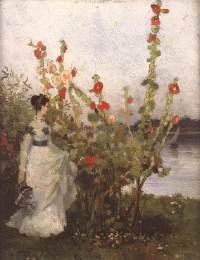
Szinyei Merse's extraordinary sense of colours was already present in his earliest works. He proved his individual way of seeing nature with his surprisingly fresh landscapes of small size during his studies in Munich in 1867-68, which made him related with French artists although he did not know them at that time yet. As opposed to his predecessors and most contemporaries, Szinyei Merse found unity of picture rather in identical light intensity of different colours than in one dominating tone, as is the case with Markó who applied golden brown colours of sunset.
In some earlier pictures, Szinyei Merse, a young artist, discovered phenomena of light and colour in open air, the problem of values which was so important for European painting to establish plein air. He used red and green as contrasting colours in Mallows first, then in Mother and Children (in an American collection), which then had a major role in Picnic in May, a significant picture of later date. The contrast of red and green does not in the least ruin the lyrical composition and its intimate atmosphere.
In Mallows, Szinyei Merse combined two favourite memories: behind the mallows in the estate of the family in Upper Hungary, he painted the picturesque landscape of Lake Starnberg, a favourite beauty spot visited by artists in Munich, as a background with sailing ships cleaving through the water. The motif of Hungarian mallows appeared in the sketch of Drying Clothes once more.